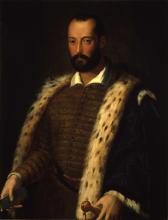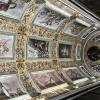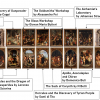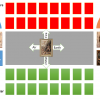
Studiolo of Francesco I de' Medici: Introduction
External links
Commentary
General Introduction
The Studiolo is a small chamber in the Palazzo Vecchio in Florence (Image 1) built for Francesco I de’ Medici (1541-1587), Grand Duke of Tuscany (1574-1587).
It hosted Francesco's vast collection of natural and artificial objects and included sculptures by Giambologna and Vincenzo de' Rossi and paintings by Giorgio Vasari (1511-1574) and Johannes Stradanus.
Francesco was an avid collector, and commissioned as early as 1564 a ‘studiolo’, which in Florentine parlance referred to a furniture cabinet. As Francesco’s collection increased, so did the requirements for storing it, and the ambition of how the storage space might look like. By 1569 Francesco decided to create a small room that would host his collection, and the work began later that year, concluding in 1575.
The Studiolo was intended to be a very private room. The access to it was mainly from Francesco’s bedroom, being, in a sense, the prince’s personal study. The only other exits, all hidden behind paintings, led to a tiny treasury room, the Tesoretto, and to a backside alley.
Besides Francesco, very few persons ever saw the Studiolo, and it was omitted from Palace drawings. The room was almost, if not completely, dark; the single window that it had was covered by one of the paintings (it is not clear whether the painting could be set aside to illuminate the space below). The only known furniture was a cabinet, where the prince presumably sat to admire some of the objects in his collection.
The decoration was entrusted to Giorgio Vasari, who was also responsible for the overall redesign of the Palazzo Vecchio. Vasari coordinated the team of painters and sculptors who executed the artworks. The conceptual design was however done by Vincenzo Borghini (1515-1580), the court’s intellectual adviser, erudite men of letters and Cosimo I’s lieutenant of the newly founded Accademia delle Arti del Disegno, the first ever artist academy.
Unsurprisingly, several of the artists were also members of the Accademia.
Borghini's View of Nature and Art
Borghini’s programme was to illustrate the alliance between Nature and Art, which in his view aided each other. The overall key is expressed by the painting in the middle of the Studiolo’s ceiling depicting Nature together with Prometheus, seen as the inventor of all arts.
In Borghini’s schema, Nature was aided by the four elements, so he attributed each of the four cardinal directions, as well as the four walls of the Studiolo, to an element. The structure of the Studiolo is explored in more depth here, and one of the walls, the Fire wall, is described in closer detail here.
The Four Walls
The walls are each divided into two stories; the upper story features rectangular paintings, while the lower story oval ones. The oval paintings are actually doors leading to cupboards containing Francesco’s collected objects (see Image 2). The objects were also divided according to the four elements; in turn, the paintings played the role of labels of drawers, identifying the main objects hiding behind them. For instance, Cleopatra’s Banquet by Alessandro Allori was the label for Francesco’s collection of pearls; this was because, according to legend, Cleopatra threw a banquet for Mark Anthony where she ostentatiously melted a pearl earring in a cup of vinegar to show how wealthy Egypt was. For some of the others we may presume what they hid: Danae and the Shower of Gold by Bartolomeo Traballesi probably fronted Francesco’s gold collection, while Giovan Maria Butteri’s Discovery of Glass most likely featured glass objects. But in other cases the contents of the cupboards are not clear: what might Lavinia at the Altar by Mirabello Cavallori front?
The Studiolo's Demise and Reconstruction
Unfortunately, we cannot be certain of the exact setup of the room’s paintings. In 1586, one year before his death, Francesco began the process of dismantling the Studiolo when he removed the bronze statues and transferred them to the much-more extravagant and visitor-facing Tribuna of the Uffizi. The succeeding ruler, Ferdinando I, continued to asset-strip the Studiolo of its paintings and collected objects. By the 19th century only the shell remained – the ceiling decorations and some of the lateral fresco paintings.
In 1910, however, two Florentine officials decided to reconstruct the Studiolo. Impressively, they were able to gather together all the paintings and statues that belonged to it. This feat has partially obscured the fact that this was a rushed job based on limited research. Since 1976, several scholars have pointed out the obvious mistakes in arranging the paintings. However, thus far no modifications to the Studiolo arrangement have been made.
Even as the current look of the Studiolo is probably quite far from its glory days, it is still a very impressive object. Other Studiolos have survived, but none had the coherence and elegance of Francesco’s. Its thematic unity is stunning, being an artistic representation of a complete Renaissance worldview.
Bibliography:
Alberts, Lindsay. "The studiolo of Francesco I de' Medici: A Recently-Found Inventory," Art Histories Supplement 2.0, 1(2015): 3-23.
Conticelli, Valentina. "Guardaroba di Cose Rare et Preziose”: Lo Studiolo di Francesco I de' Medici - Arte, Storia e Significati. Lugano, Switzerland: Agorà, 2007.
Edwards, Karen Victoria. “Rethinking the Installation of the Studiolo of Francesco I de’ Medici in the Palazzo Vecchio”. PhD diss., Case Western Reserve University, 2007.
Feinberg, Larry. “The Studiolo of Francesco I Reconsidered,” in The Medici, Michelangelo, and the Art of Late Renaissance Florence, pp. 46-65. New Haven: Yale University, 2002.
Rinehart, Michael. "A Document for the Studiolo of Francesco I," in Art the Ape of Nature: Studies in Honor of H.W. Janson. Edited by Moshe Barasche and Lucy Freeman Sandler. New York: Harry Abrams, 1981.
Schaefer, Scott. “The Studiolo of Francesco I de’ Medici in the Palazzo Vecchio in Florence”. PhD diss., Bryn Mawr College, 1976.
Commentary: Georgiana Hedesan (January 2022).



